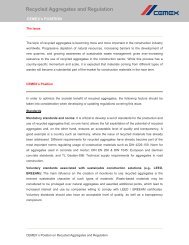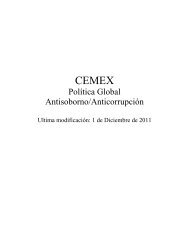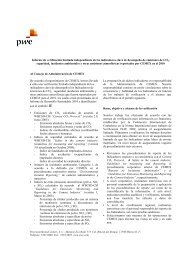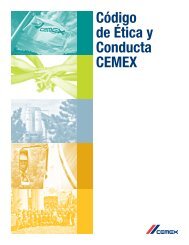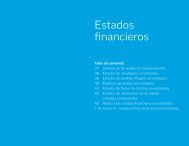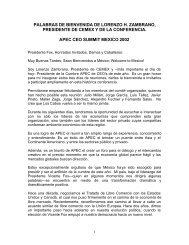building a STRONGER foundation - Cemex
building a STRONGER foundation - Cemex
building a STRONGER foundation - Cemex
Create successful ePaper yourself
Turn your PDF publications into a flip-book with our unique Google optimized e-Paper software.
Covenants<br />
CEMEX, S.A.B. DE C.V. AND SUBSIDIARIES<br />
Notes to the Consolidated Financial Statements – (Continued)<br />
As of December 31, 2010, 2009 and 2008<br />
(Millions of Mexican pesos)<br />
Most debt contracts of CEMEX require the compliance with financial ratios calculated on a consolidated basis, which mainly include: a) the<br />
ratio of net debt to operating EBITDA (“leverage ratio”); and b) the ratio of operating EBITDA to financial expense (“coverage ratio”).<br />
Financial ratios are calculated according to formulas established in the debt contracts and require in most cases pro forma adjustments, using<br />
definitions that differ from terms defined under MFRS.<br />
As of December 31, 2010, 2009 and 2008, taking into account the Financing Agreement and the amendments thereto, the modifications to the<br />
credit contracts and the waivers obtained, CEMEX, S.A.B. de C.V. and its subsidiaries were in compliance with the restrictive covenants<br />
imposed by its debt contracts.The main consolidated financial ratios were as follows:<br />
Consolidated financial ratios 1 2010 2009 2008<br />
Leverage ratio 2, 3......................................................................................... Limit =< 7.75 N/A =< 4.5<br />
Calculation 7.43 N/A 4.04<br />
Coverage ratio 4........................................................................................... Limit > 1.75 N/A > 2.5<br />
Calculation 1.95 N/A 4.82<br />
1 Beginning on August 14, 2009, even though the financial ratios under the Financing Agreement use similar terminology, they are calculated differently as<br />
compared to the financial ratios effective until December 31, 2008 and before the completion of the Financing Agreement.<br />
2 The leverage ratio is calculated in pesos by dividing “funded debt” by pro forma operating income plus depreciation and amortization (“operating<br />
EBITDA”) for the last twelve months as of the calculation date. Funded debt equals debt, as reported in the balance sheet, excluding finance leases, plus<br />
perpetual debentures and guarantees, minus convertible securities, plus or minus the fair value of corresponding derivative financial instruments, among<br />
other adjustments. In 2008, the leverage ratio was calculated in U.S. dollars using net debt by pro forma operating EBITDA for the last twelve months as of<br />
the calculation date. Net debt included debt, as reported in the balance sheet, plus the negative fair value or minus the positive fair value of cross currency<br />
swap derivative financial instruments associated with debt, minus cash and temporary investments.<br />
3 For purposes of calculating the leverage ratio, the pro forma operating EBITDA represents, all calculated in pesos, operating EBITDA for the last twelve<br />
months as of the calculation date, plus the portion of operating EBITDA referring to such twelve-month period of any significant acquisition made in the<br />
period before its consolidation in CEMEX, minus operating EBITDA referring to such twelve-month period of any significant disposal that had already been<br />
liquidated. In 2008, pro forma operating EBITDA was determined also in pesos, but considering a different conversion methodology, and included financial<br />
income.<br />
4 The coverage ratio is calculated in pesos using the amounts arising from the financial statements, by dividing the pro forma operating EBITDA by the<br />
financial expense for the last twelve months as of the calculation date. Financial expense includes interest accrued on the perpetual debentures. In 2008, the<br />
coverage ratio was calculated also in pesos but considering a different conversion methodology. Operating EBITDA included financial income, while<br />
financial expense did not include interest accrued on the perpetual debentures.<br />
On October 25, 2010, amendments were made to the Financing Agreement financial ratios and tests, including a coverage ratio of not less<br />
than (i) 1.75 times for each semi-annual period beginning on June 30, 2010 through December 31, 2012; and (ii) 2.0 times for the remaining<br />
semi-annual periods to December 31, 2013. In addition, the maximum leverage ratio must not exceed 7.75 times for each semi-annual period<br />
beginning on June 30, 2010 through the period ending June 30, 2011, decreasing to 7.0 times for the period ending December 31, 2011, and<br />
decreasing gradually for subsequent semi-annual periods to 4.25 times for the period ending December 31, 2013.<br />
Upon completion of the Financing Agreement in August 2009 and before the amendments described above, the consolidated ratio of<br />
operating EBITDA to financial expense was of not less than: (i) 1.75 times for each semi-annual period beginning on June 30, 2010 through<br />
the period ending on June 30, 2011; (ii) 2.0 times for each semi-annual period through December 31, 2012; and (iii) 2.25 times for the<br />
subsequent semi-annual periods until December 31, 2013. In addition, the maximum leverage ratio was of 7.75 times for each semi-annual<br />
period beginning on June 30, 2010, decreasing gradually in subsequent semi-annual periods until reaching 3.50 times for the period ending<br />
December 31, 2013. For the year ended December 31, 2009, no such financial ratios under the Financing Agreement were applicable.<br />
CEMEX will classify all of its outstanding debt as current debt in the CEMEX’s balance sheet if: 1) as of any relevant measurement date on<br />
which CEMEX fails to comply with the financial ratios agreed upon pursuant to the Financing Agreement; or 2) as of any date prior to a<br />
subsequent measurement date on which CEMEX expects not to be in compliance with its financial ratios agreed upon under the Financing<br />
Agreement, in the absence of: a) amendments and/or waivers covering the next succeeding 12 months; b) high probability that the violation<br />
will be cured during any agreed upon remediation period and be sustained for the next succeeding 12 months; and/or c) a signed refinancing<br />
agreement to refinance the relevant debt on a long-term basis. The aforementioned classification of debt as short-term could have a material<br />
adverse effect on CEMEX’s liquidity and financial position.<br />
F-37



